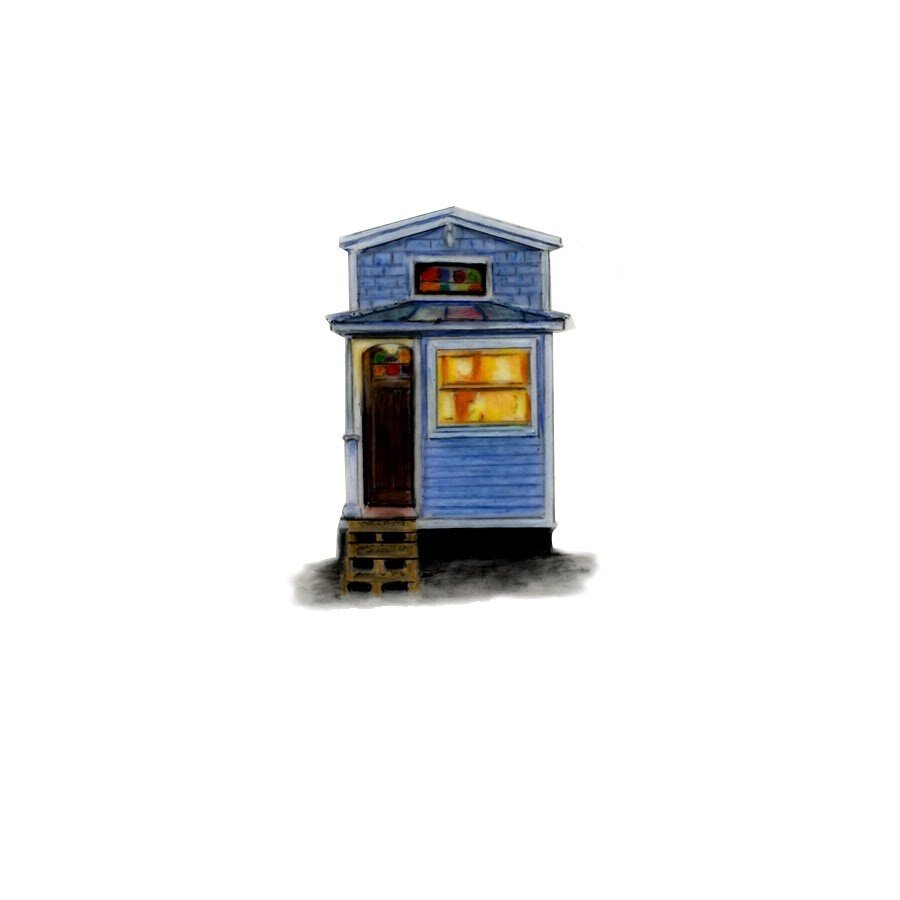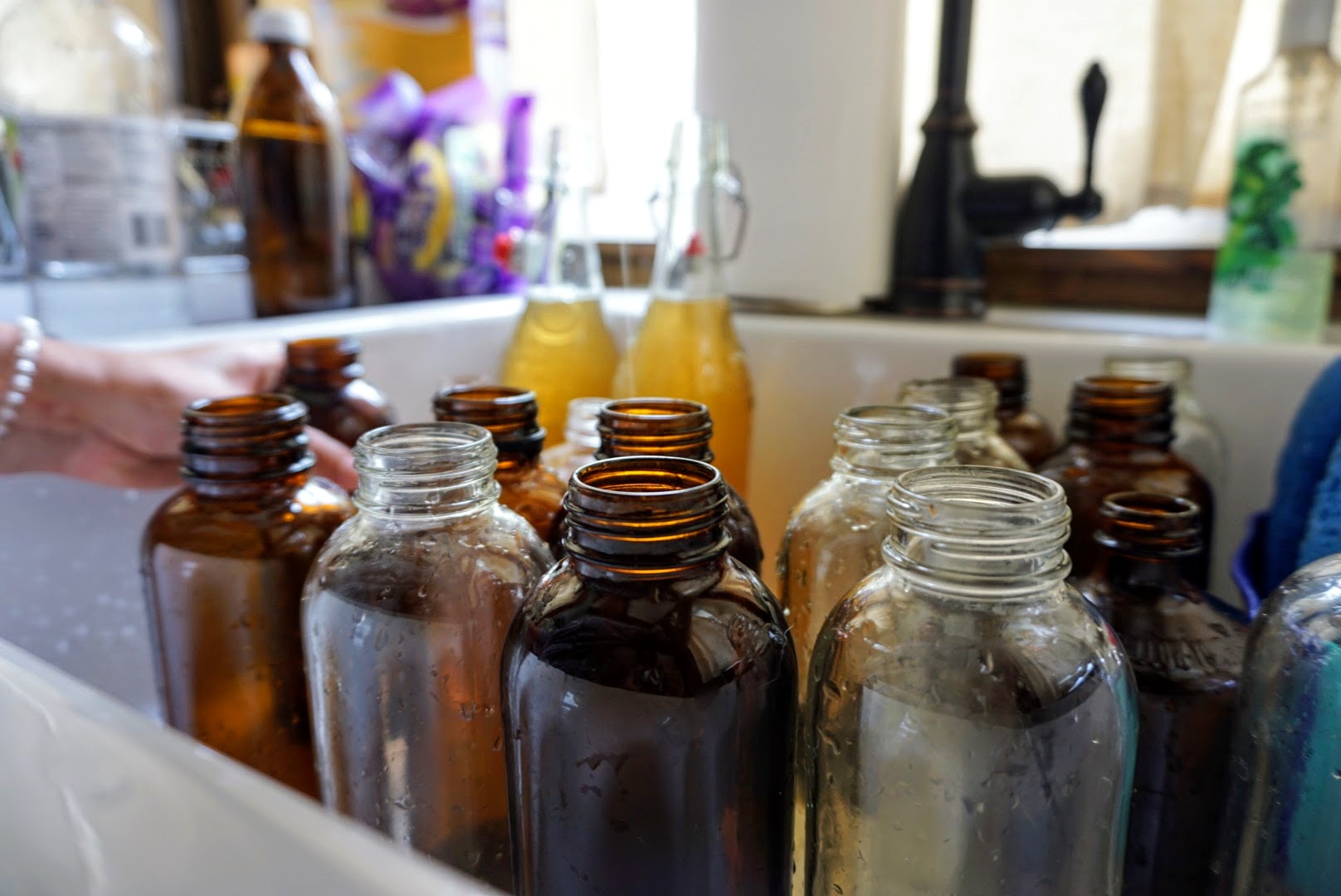Tiny Home Kombucha Brewing
Helloooooooo internet!
Popping in to let you know about the yummy carbonated goodness that is kombucha!
A few months before we moved into our tiny, I started brewing my own kombucha. What's that you ask? Kombucha is a fermented drink made with tea that is carbonated and full of health-promoting probiotics. Once we started drinking it, Tim and I both knew we would make room in our tiny home for me to continue brewing. Even though space is limited in our home, I have an entire cabinet shelf dedicated to my brew culture and bottles.
For those of you that aren't on the probiotic train yet, do your gut a favor and hop on board! I'm a wellness coach, so I give nutritional counseling for a living. I cannot tell my clients enough what adding probiotics into the mix did for my health. My skin is better, my mood is more regulated, my digestion is better, and I'm more regular in the restroom (don't be afraid to have this conversation, everyone goes!). Probiotics balance and restore the healthy bacteria in your gut that help you break down your food and fuel your body. If you haven't yet, give them a shot!
Kombucha isn't the only way to get probiotics, but it sure is a yummy way and the right choice for us. Tim likes drinking soda so the carbonation is satisfying for him, and I love tea and feeling great so the health benefits are a win for me. Here are some photos of my baby alien SCOBY and a how-to if you're interested in brewing your own!
Step 1: Acquire a SCOBY.
SCOBY stands for Symbiotic Culture Of Bacteria and Yeast. It's a living culture that ferments and carbonates your tea into the yummy goodness that is kombucha. It looks like an alien, and definitely takes some getting used to. But once you see how great it is you won't be shy! At this point, I have named my SCOBY and we are besties :) I give her a home and she takes care of my gut health!
Where can you get a SCOBY?
There are a few options here.
A) You can grow your own from a store-bought bottle of kombucha (maybe). Some vendors pasteurize their kombucha for sanitation reasons, which kills the culture and sort of defeats the purpose. So if you choose this route, make sure your store-bought 'booch is unflavored, raw, and unpasteurized. You'll combine the store-bought with some homemade sweet tea and be very patient, as this method can take 4-6 weeks. You'd be growing a baby SCOBY from scratch. I tried this method with no success and eventually ended up purchasing a culture elsewhere. However, I have seen some have success with this method, so use your best judgment.
B) You can purchase a SCOBY from an online vendor. Places like Kombucha Kamp make SCOBYs specifically to sell to new homebrewers looking to get started. They also sell entire sets to get you up and running. This is a nice option if you don't mind spending a little cash to get you started and to get everything you'd need all at once instead of piecemeal like I did. Websites that provide kits usually also have some awesome resources for new brewers. If you want to save some money and are hunting for a bargain, you can get just the culture and search for your own equipment. You can find a SCOBY from several sources online like KKamp or Amazon. I've even seen one for sale on Craigslist! If you choose this option, make sure that your SCOBY comes delivered in starter liquid (a fancy term for strong kombucha).
C) Find a booch brewing friend! Because the SCOBY is alive, it grows! I have grown baby SCOBYs and given them away to friends. It's fun to share this hobby with others and to help them get started. Share the probiotic wealth!
Step 2: Brew the tea.
Once you have your SCOBY, you'll need a glass container like this one to store your tea as it ferments. I usually do 2 gallons at a time because there are 2 of us. To make the tea, you'll use a tea your choice and 1 cup of sugar per gallon of water. This sounds like a lot of sugar, but your SCOBY eats the sugar and puts out carbon dioxide, which is what makes your booch fizzy! The end result is fairly low in sugar. I use an organic, locally made sugar, but any white sugar will do. Avoid using raw honey, as it is naturally antibacterial and may harm your SCOBY. Wondering what kind of tea to use? The sky is the limit! I usually blend a black darjeeling and a Japanese green tea and add flavor during the bottling process, but feel free to experiment with flavored teas and different combinations! As for the water source, I typically stick to distilled water as tap water has impurities that might inhibit the growth of your SCOBY. If you choose to use tap water, boil it for a few minutes to allow the impurities and the chlorine to evaporate. Once your tea cools, combine the tea, 1 cup of starter liquid, and the SCOBY in your glass container. Cover with something that will allow it to breathe and keep the odd fruit fly out. We use an old t-shirt and a rubber band.
Step 3: Wait.
It can take anywhere from 7 days to a full 30 days for your 'booch to be ready. You are the deciding factor here, so if you like a sweeter taste, stick to a shorter fermentation time. If you dig a vinegary, sour 'booch, wait longer. Feel free to taste test throughout your ferment (carefully) and decide when it's perfect for you. Remember, if it's too sweet, wait longer. If it's too vinegary, it can be tough to fix but you may add more sweet tea and do a shorter ferment.
Step 4: Bottle!
This is the fun part! Let your creativity shine. Once you bottle, you can do what's called a second ferment. This step allows you to flavor the kombucha to your taste. It also carbonates the drink! You can add fruit to your bottles and ferment for an additional 2-4 days. The sugar from the fruit feeds the living culture your first ferment introduced into your brew. The culture consumes the sugar, produces carbon dioxide, and creates a fizzy texture. After the second ferment, you can move the bottles into the fridge to slow the fermentation process and chill your yummy brew. If this isn't your jam, you can just bottle the kombucha so that it's easier to access and enjoy it as is!
We use kombucha bottles from store-bought 'booch that have been cleaned thoroughly and stripped of the labels. I also scored some awesome flip-top bottles for our plain-flavored 'booch that can be tough to carbonate. The better the seal, the less gas can escape and instead dissolves into your 'booch, giving you a fizzier brew! Yay science! In total, I have maybe 15 bottles, plus the 2 flip-tops. They take up an entire shelf in our fridge after the second ferment, so Tim stays on me about minimizing our bottles. Some of them will soon be donated to a friend interested in brewing. :)
To produce the flavor you want, you can use fresh fruit, fruit juice, herbs, essential oils (make sure they're food grade), food extracts, and you can even experiment with the tea you brew with. The sky is the limit here. Remember, the higher the sugar content of your flavor choices, the fizzier your brew will be. The fizziest brews we have had come from pineapples, strawberries, and mangos (all high-sugar fruits).
If you choose a fruit that is high in sugar, you may opt to "burp" your brew after 24 hours to prevent a fizzy mess (think opening a shaken soda can). If I flavor with fruits that are lower in sugar, I sometimes choose to add a pinch of the same sugar I used to brew the tea. This is especially helpful in our plain flavor. Among our favorite flavors are strawberry pineapple, cherry vanilla, mixed berry, blueberry pineapple, and mango strawberry. On my most recent brew, I decided to try my hand at using fresh herbs, so we have some exciting flavors on a second ferment! On the menu is strawberry basil, mint lemonade, coconut mojito, blackberry mint, and berry lemonade. YUM!
This process is very simple, even in our small space. The ingredients are all things we use anyways. The equipment involves a large pot to boil water, a spoon to stir, a measuring cup, and the ingredients. Maybe a cutting board and knife for the flavoring process. It's simple and it makes us feel great, so we chose to incorporate it into our everyday lives even while living tiny. Remember, brewing your own kombucha isn't the only option. Store-bought brews can be just as delicious and beneficial as a homebrew!
Whether you're considering trying kombucha for the first time or wanting to start your own brew, I hope this helped! How do you take care of your gut health? What brewing tips do you have? Comment below!
-Sam
If you found this article useful please check our Facebook and Instagram links at the bottom of this page to stay up to day with our other news!









